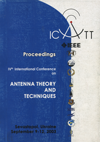An adaptive parameter estimation of Gaussian signal in the presence of an unknown Gaussian noise
DOI:
https://doi.org/10.1109/ICATT.2003.1239245Keywords:
maximum-likelihood parametric estimation, Gaussian signal, adaptive beamformerAbstract
The parametric estimation technique for a source emitting white Gaussian noise in the presence of white Gaussian noise background with an unknown covariance matrix is considered. Simultaneous estimation of both the source parameters and the unknown covariance matrix of noise background can be conducted when the source moves, i.e. its steering vector varies in time. For this scenario, the maximum likelihood statistic was derived for estimation of the source power and the noise covariance matrix. Simplification of maximum likelihood equations was performed assuming a great number snapshot vectors and low signal-to-noise ratio. The results of stochastic numerical simulation are given in case of a point source moving across the uniform sensor array (it was assumed that the source track lies in near-field zone of sensor array) in the presence of uniform noise background and strong interference. The effectiveness of the adaptive beamformer using the inverse estimate of the covariance matrix of non-uniform noise background was demonstrated.References
Matveyev, A.L.; Gershman, A.B.; Boehme, J.F. On the direction estimation Cramer-Rao bounds in the presence of uncorrelated unknown noise. Circuits, Syst., Signal Process., Vol. 18, p. 479- 487, 1999.
Pesavento, M.; Gershman, A.B. Maximum-likelihood direction-of-arrival estimation in the presence of unknown nonuniform noise. IEEE Trans. Signal Processing, Vol. 49, p. 1310-1324, Jul. 2001.
Vdovicheva, N.K.; Turchin, V.I.; Fiks, I.S. Remote sensing of moving wide-band sources. Radiophysics and Quantum Electronics, Vol. 41, No. 9, p. 783-792, 1998.
Published
2003-09-14
Issue
Section
Adaptive antenna arrays and signal processing

